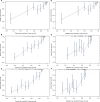A sample model established by S-index predicting overall survival after curative resection of primary hepatocellular carcinoma
- PMID: 30679923
- PMCID: PMC6338126
- DOI: 10.2147/CMAR.S193593
A sample model established by S-index predicting overall survival after curative resection of primary hepatocellular carcinoma
Abstract
Purpose: Prognostic prediction after curative resection of primary hepatocellular carcinoma (PHCC) remains an arduous task. The S-index calculated from γ-glutamyl transpeptidase, albumin, and platelets is reported to predict the severity of liver fibrosis. We constructed a nomogram for predicting the survival probability of PHCC based on a new indicator, the S-index, combined with other routine clinical parameters.
Patients and methods: We selected 490 patients with PHCC postradical surgery at the First Affiliated Hospital of Wenzhou Medical University between January 2007 and January 2014. The subjects were randomly allocated into the training cohort and the validation cohort in the ratio 7:3 by the digital method. Important variables screened by univariate analysis were included in multivariate analysis to obtain independent risk factors for predicting the prognosis of PHCC. The construction of the nomogram was based on Cox proportional hazard regression models. The concordance index (C-index) was used in the nomogram for evaluating the model performance for prognosis. We drew time-dependent receiver operating characteristic curves to compare our model with other staging systems.
Results: The nomogram based on six independent risk factors after multivariate analyses had good predictive power after radical surgery of PHCC. In the training and validation groups, the C-index of the nomogram was highly consistent for evaluating survival from PHCC. Compared with the traditional scoring system, the areas under time-dependent receiver operating characteristic curves were 0.7382, 0.7293, and 0.7520 for 1-, 3-, and 5-year overall survival, respectively. In summary, the nomogram showed excellent results in terms of prognosis of PHCC.
Conclusion: Based on the S-index and the other clinical indicators, we developed a precise nomogram that predicts the survival probability of patients with PHCC after radical surgery. This tool can provide effective information for surgeons and patients.
Keywords: PHCC; nomogram; prognosis; radical resection.
Conflict of interest statement
Disclosure The authors report no conflicts of interest in this work.
Figures




Similar articles
-
Development and validation of a risk score for predicting mortality after resection of primary hepatocellular carcinoma.Aging (Albany NY). 2020 Jun 21;12(12):11878-11892. doi: 10.18632/aging.103360. Epub 2020 Jun 21. Aging (Albany NY). 2020. PMID: 32568098 Free PMC article.
-
Use of a novel index, the A-index, and its associated nomogram to predict overall survival rates after resection of primary hepatocellular carcinoma.Clin Chim Acta. 2020 Jan;500:34-41. doi: 10.1016/j.cca.2019.10.001. Epub 2019 Oct 23. Clin Chim Acta. 2020. PMID: 31655054
-
Nomogram Based on Systemic Immune Inflammation Index and Prognostic Nutrition Index Predicts Recurrence of Hepatocellular Carcinoma After Surgery.Front Oncol. 2020 Oct 14;10:551668. doi: 10.3389/fonc.2020.551668. eCollection 2020. Front Oncol. 2020. PMID: 33163397 Free PMC article.
-
A Powerful Nomogram Based on the Novel D-Index to Predict Prognosis After Surgical Resection of Hepatocellular Carcinoma.Cancer Manag Res. 2021 Mar 17;13:2581-2594. doi: 10.2147/CMAR.S305253. eCollection 2021. Cancer Manag Res. 2021. PMID: 33762849 Free PMC article.
-
A Simple Model Established by Blood Markers Predicting Overall Survival After Radical Resection of Pancreatic Ductal Adenocarcinoma.Front Oncol. 2020 Apr 30;10:583. doi: 10.3389/fonc.2020.00583. eCollection 2020. Front Oncol. 2020. PMID: 32426277 Free PMC article.
Cited by
-
Development and validation of a prognostic nomogram for HIV/AIDS patients who underwent antiretroviral therapy: Data from a China population-based cohort.EBioMedicine. 2019 Oct;48:414-424. doi: 10.1016/j.ebiom.2019.09.031. Epub 2019 Oct 5. EBioMedicine. 2019. PMID: 31594752 Free PMC article.
-
Development and Validation of a Website to Guide Decision-Making for Disorders of Consciousness.Front Aging Neurosci. 2022 Jul 7;14:934283. doi: 10.3389/fnagi.2022.934283. eCollection 2022. Front Aging Neurosci. 2022. PMID: 35875805 Free PMC article.
-
Model to Predict Overall Survival in Patients With Hepatocellular Carcinoma After Curative Hepatectomy.Front Oncol. 2021 Mar 5;10:537526. doi: 10.3389/fonc.2020.537526. eCollection 2020. Front Oncol. 2021. PMID: 33747893 Free PMC article.
-
Development and validation of a risk score for predicting mortality after resection of primary hepatocellular carcinoma.Aging (Albany NY). 2020 Jun 21;12(12):11878-11892. doi: 10.18632/aging.103360. Epub 2020 Jun 21. Aging (Albany NY). 2020. PMID: 32568098 Free PMC article.
-
Prognostic Nomograms for Patients with Hepatocellular Carcinoma After Curative Hepatectomy, with a Focus on Recurrence Timing and Post-Recurrence Management.J Hepatocell Carcinoma. 2020 Oct 27;7:233-256. doi: 10.2147/JHC.S271498. eCollection 2020. J Hepatocell Carcinoma. 2020. PMID: 33154956 Free PMC article.
References
-
- Wallace MC, Preen D, Jeffrey GP, Adams LA. The evolving epidemiology of hepatocellular carcinoma: a global perspective. Expert Rev Gastroenterol Hepatol. 2015;9(6):765–779. - PubMed
-
- Bruix J, Reig M, Sherman M. Evidence-based diagnosis, staging, and treatment of patients with hepatocellular carcinoma. Gastroenterology. 2016;150(4):835–853. - PubMed
-
- Cai BB, Shi KQ, Li P, et al. A nomogram integrating hepatic reserve and tumor characteristics for hepatocellular carcinoma following curative liver resection. Clin Chim Acta. 2018;485:187–194. - PubMed
-
- Choi WM, Lee JH, Ahn H, et al. Forns index predicts recurrence and death in patients with hepatitis B-related hepatocellular carcinoma after curative resection. Liver Int. 2015;35(8):1992–2000. - PubMed
LinkOut - more resources
Full Text Sources

